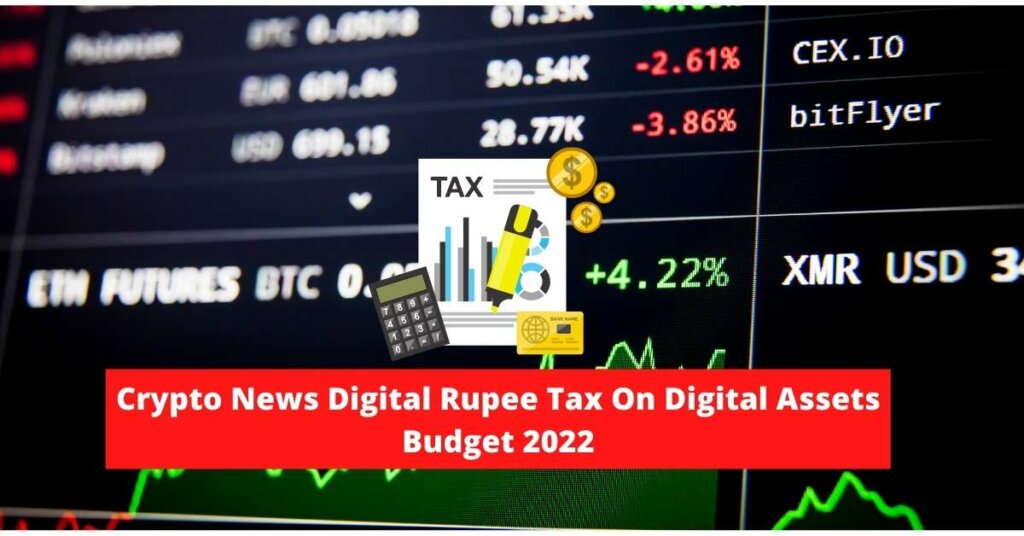Crypto News Digital Rupee Tax On Digital assets Budget 2022:The government intends to introduce a Digital Rupee, also known as Central Bank Digital Currency (CBDC), in 2022-23. Furthermore, the Budget suggested a 30% tax on virtual assets, thereby legalising the trade of private cryptocurrencies and non-fungible tokens. This is essentially consistent with the Centre’s aspirations to create a fiat digital currency while prohibiting the use of private virtual currencies as legal tender.
The Finance Minister also suggested levying TDS on payments made in connection with the transfer of virtual digital assets at a rate of 1% of such consideration above a monetary threshold. It has also been recommended that gifts of virtual digital assets be taxed in the recipient’s hands.
Budget 2022: Tax on Virtual Assets
According to Sanjeev Sanyal, Principal Economic Adviser, the government was expected to adopt a balanced approach to cryptocurrencies. Meanwhile, the Economic Survey 2022, which was tabled in Parliament on Monday (January 31, 2021), included no mention of cryptocurrencies or Blockchain. It is also quite improbable that a Cryptocurrency Regulation Bill would be proposed in Parliament during the current Budget Session.
The government has taken a cautious stance on crypto asset taxes, setting a flat 30% tax on such revenue. Finance Minister Nirmala Sitharaman stated in her Budget Speech 2022 that revenue from the transfer of virtual digital assets would be taxed at 30%. She also noted that no set-off would be permitted in the event of a defeat. Gifts of virtual digital assets would also be taxed in the recipient’s hands.
Also read::
NFT Definition, Meaning,How to Buy, Sell & Create NFT for Free

Budget 2022: Digital Rupee
Sitharaman remarked during the Budget 2022 debate in Parliament, “Digital money would also lead to a more efficient and cheaper currency management system.” As a result, it is suggested that the Reserve Bank of India produce digital rupees utilising Blockchain and other technology beginning in 2022 and 2023.”
The decision aligns with the government’s plans to draft a cryptocurrency Bill that will prevent “any private cryptocurrencies in India” with “limited exceptions.” The Indian government will not be the first to create a digital currency. In October 2021, Nigeria created eNaira, a CBDC that does not pay interest. CBDCs have also been established in the Bahamas and five other East Caribbean islands.
What is Blockchain, and how will the Digital Rupee be built on it?
A blockchain is simply a digital record of transactions replicated and distributed throughout the Blockchain’s complete network of computer systems. Each block on the chain comprises several transactions, and whenever a new transaction happens on the Blockchain, a record of that transaction is added to the ledger of every participant. Distributed Ledger Technology refers to a decentralised database administered by several individuals (DLT).
This implies that if one block in a chain were modified, it would be evident that it had been tampered with. To disrupt a blockchain system, hackers would have to alter every block across all distributed copies of the chain.
Crypto News
Vitalik Buterin, the co-founder of Ethereum, receives $100 million in donated cryptocurrency from the India Crypto Relief Fund Read Full news Below:::
On May 12, 16:37 ET, Buterin gave 50 trillion SHIB tokens worth $1.2 billion (approximately Rs 8,800 crores) to the India Covid Relief Fund in a single transaction. Sandeep Nailwal, co-founder and COO of Polygon and an Indian IT entrepreneur, established the COVID Relief Fund. Buterin had given $600,000 (approximately Rs 4.41 crores) in ether and maker tokens to the India COVID Relief Fund in April. Nailwal thanked Buterin on Twitter. He stated that the monies would be utilised wisely.
However, Sandeep and Buterin are now attempting to develop and implement several techniques to expedite rescue operations in India. To that end, they devised a solution by transferring $100 million USDC back to Vitalik to conduct rapid deployment in a high risk/reward environment. They would distribute the assets in USDC, a stablecoin tethered to the US dollar. According to Sandeep, the decision to return some of the money to Vitalik was primarily motivated by avoiding a confrontation with Indian rules governing the distribution of relief contributions.
Buterin is advocating for a transparent method of distributing the assets, and he has co-founded a new organisation called Balvi to supervise the process on his behalf. Balvi will use the “SHIB money” primarily for vaccine research and development, novel air filtration initiatives, and testing, among other things.
| Homepage | Click here |